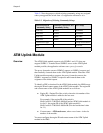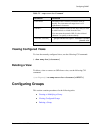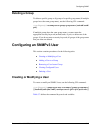
5-10 User Guide for the Avaya P580 and P882 Multiservice Switches, v6.1
Chapter 5
CAUTION:
SNMPv3
Administrator
After either manually assigning the switch an engine ID or assigning the
console port an IP address, you can create an SNMPv3 administrator. This
administrator will be able to create and modify SNMPv3 users by using
SNMP.
You must have administrator access to the switch to create the SNMPv3
administrator. The administrator can, however, give specific user groups
read-write access to the USM and VACM MIBs. Users assigned to those
user groups can then use SNMP to create or modify SNMPv3 users.
To prevent SNMPv1 or v2 access to the USM or VACM MIBs, assign views
that include these MIBS only to groups that require authentication and
encryption.
Changing the Engine ID of the Switch
You can override the default engine ID, which is based on the IP address of
the switch. After changing the engine ID, however, you must change all
SNMPv3 user passwords. For information on changing SNMPv3 user
passwords, see “Changing a User Password.”
*Important: Each switch must have a unique engine ID. If you
change the default engine ID of a switch, make sure
that no duplicates exist in your network.
To change the engine ID of the switch, use the following CLI command:
(configure)# snmp-server engineid [<engine-Id>]
Table 5-3 provides an explanation of the command variable.
Table 5-3. snmp-server engineid Command
Parameter Definition
<engine-Id> A 12-byte hexidecimal value. Separate each byte with
a colon. Do not use all 00s or all FFs.
Example: 00:00:00:09:0a:fe:ff:12:97:33:45:00.
Important: The last byte of the engine ID must be
00. This restriction makes SNMP access
to the ATM Uplink module possible.
The engine ID of an ATM Uplink module
is the engine ID of the switch, where the
slot number of the ATM Uplink module is
added to the last byte.


















